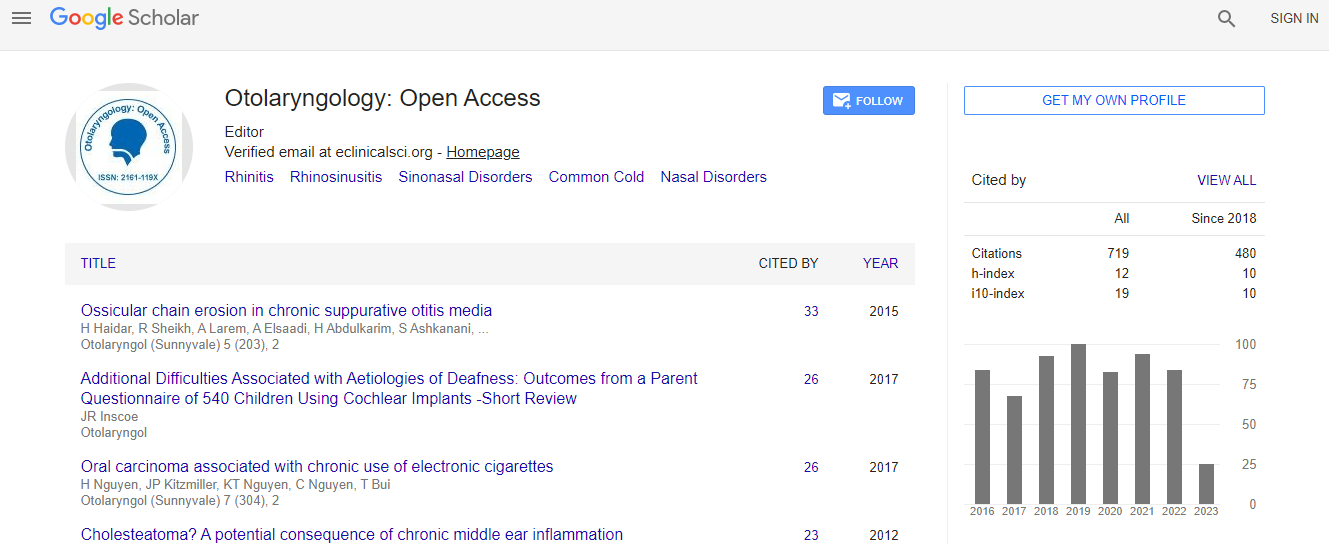Our Group organises 3000+ Global Conferenceseries Events every year across USA, Europe & Asia with support from 1000 more scientific Societies and Publishes 700+ Open Access Journals which contains over 50000 eminent personalities, reputed scientists as editorial board members.
Open Access Journals gaining more Readers and Citations
700 Journals and 15,000,000 Readers Each Journal is getting 25,000+ Readers
Google Scholar citation report
Citations : 925
Otolaryngology: Open Access received 925 citations as per Google Scholar report
Otolaryngology: Open Access peer review process verified at publons
Indexed In
- Index Copernicus
- Google Scholar
- Sherpa Romeo
- Open J Gate
- Genamics JournalSeek
- RefSeek
- Hamdard University
- EBSCO A-Z
- OCLC- WorldCat
- Publons
- Geneva Foundation for Medical Education and Research
- ICMJE
Useful Links
Recommended Journals
Related Subjects
Share This Page
Diagnostic disparities in major salivary gland tumors
Global Summit and Medicare Expo on Head & Neck Surgery
Sourabha K Patro, Naresh K Panda, Jaimanti Bakshi, Roshan Verma, Ashim Dass and Debajyoti Chatterjee
Post Graduate Institute of Medical Education and Research, India
Posters-Accepted Abstracts: Otolaryngol (Sunnyvale)
Abstract
Objective: This study aimed to analyze diagnostic disparities encountered while dealing with major salivary gland malignancies and implicates its role in deciding whether to resort only to the FNAC reports in major salivary gland lesions to determine the treatment plan to avoid under treatment in malignant lesions having benign FNAC diagnosis. Methodology: A retrospective analysis of treatment records of major salivary gland tumors operated in the Department of Otolaryngology and Head and Neck Surgery from August 2008 to July 2014 was done. Those having discrepancy between FNAC and post-operative biopsy were further reviewed to evaluate the accuracy of the FNAC and biopsy diagnoses given earlier by reexamination of the slides. Results: A total of 128 surgeries including 13 revision surgeries were performed for 113 parotid, 14 submandibular gland and one sublingual gland lesions. These surgeries were performed on 72 males with 17 malignant, 54 benign and one metastatic lesion and 56 females with 13 malignant and 43 benign lesions. 5 out of 128 (3.90%) surgeries performed on FNAC proven benign lesions were found to be malignant in the post-operative biopsy. 4 FNAC diagnosed cases of pleomorphic adenoma were found to be mucoepidermoid Ca in 2 cases and adenoid cystic Ca and epithelial myoepithelial Ca in one case each. One case of Warthin�s tumor was post-operatively diagnosed as mucoepidermoid Ca. Conclusion: With such an incidence (5 of 128 i.e., 3.90%) of under diagnosis of major salivary gland lesions in preoperative FNAC questions the diagnostic accuracy of fine needle aspiration cytology. In view of the mimicking cytological pictures leading to a misdiagnosis seen both in the present study and in the literature, guide the clinician to decide surgical planning based on clinical, radiologic and intraoperative findings along with the FNAC rather than FNAC alone.Biography
Email: sourabhlipi@gmail.com

 Spanish
Spanish  Chinese
Chinese  Russian
Russian  German
German  French
French  Japanese
Japanese  Portuguese
Portuguese  Hindi
Hindi 
